

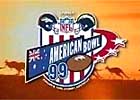
Click '99 logo for some
photos of the big day


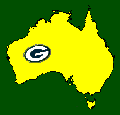
|

|
Earl "Curly" Lambeau

|
- Born April 9, 1898,in Green Bay, Wisconsin
- Died June 1, 1965,at age of 67.
- 1919-1949 Green Bay Packers
- 1950-1951 Chicago Cardinals
- 1952-1953 Washington Redskins
|
As a fullback
at Notre Dame in 1918, Lambeau was the only freshman to win a letter.
However, he had to leave school because of tonsillitis and he got a job
with the Indian Packing Corporation in Green Bay.
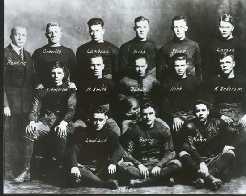
1918 Notre
Dame football team
Lambeau Back Row 3rd on right
(All American Sports Library)
|
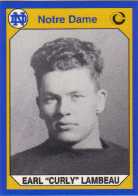
|
|
Back in Green Bay, he
was offered $250 a month to work for the Indian Packing Company. A year later
in 1919, Lambeau talked
his employer into putting up $500 to buy uniforms and equipment for this
semi-professional football team that became known as the "Packers". Lambeau
became the team's coach and playing captain.
|
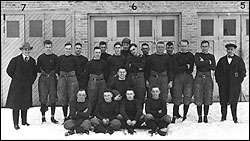
|
The players
held their first practice on Sept. 3, 1919 and played their first game on
Sept. 14, against the Menominee North End A.C. Green Bay won that game, 53-0.
Green Bay's one-sided victory over Menominee in its first game was the first
of 10 consecutive triumphs in a season that saw Green Bay out score its opponents
565-6. Green Bay's only loss in that first season came in its last game,
on Nov. 23, at the hands of a team that curiously called itself the Beloit
"Fairies". The Green Bay Gazette reported the next day "Capt. Lambeau's team
was robbed of victory by Referee Zabel of Beloit." Apparently, Lambeau scored
three touchdowns that were called back on illegal motion penalties by Mr.
Zabell.
|
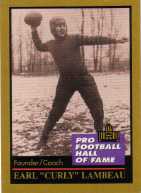
|
The
team in 1921 entered the American Professional Football Association, which
became the National Football League the following year. Green Bay's first
year in the 'big league' was more humbling than previous seasons, finishing
with a 3-2-1 record, against better-organised squads from larger cities.
Lambeau was the first
pass-minded coach in the NFL and his teams were like their leader, impatient
and explosive. An excellent passer in his own right, Curly flew in the face
of common practice.As player-coach, Lambeau emphasised the forward pass much
more than most professional coaches of the time. Despite rules that made
it difficult to use the forward pass, Lambeau's Packers were a team whose
main offensive weapon was the pass; at any time, on any down, from anywhere
on the field.
|
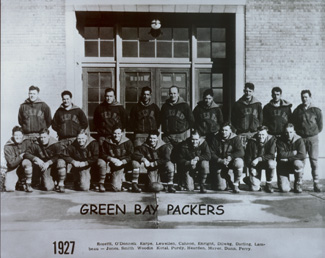
Curly Lambeau featured
in the photo Back Row (R)
By 1927
Curly began devoting more time to coaching and managing the team and less
time to playing halfback. He signed a number of players in 1927 who would
contribute greatly in the championship years ahead. From the dissolved Milwaukee
Badgers, he picked up end LaVern Dilweg and quarterback Red Dunn. All of
these additions helped bring the Packers to a 7-2-1 record which allowed
them to come in second to the New York Giants.
|
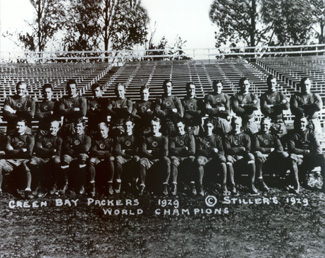 Featured in the photo Front Row (L to
R): 20 Curly Lambeau
Featured in the photo Front Row (L to
R): 20 Curly Lambeau
|
In 1929,
after retiring as a player, Curly replaced himself with future Hall of Fame
quarterback, Arnie Herber.who became the NFL's first great long-distance
passer.
Curly Lambeau's gift
for recognising and obtaining talent reached new heights this season when
he acquired three future Hall of Famers.
Over the summer, the New
York Yankees had folded and Lambeau plucked guard Mike Michalske, from Penn State, from the remains. From
the Giants, Lambeau signed disgruntled tackle Cal Hubbard, a giant of a man at 6-5 and 250 pounds.
|
His most colorful addition, however, was halfback John 'Blood' McNally who he away from the Pottsville Maroons.
Blood's off the field exploits rivaled his on the field accomplishments.
He could run, pass, and punt with the best of them, but perhaps more importantly,
he was the best pass catching back in the league.
The Packers won the first
of three consecutive championships that season. From 1929 through 1931, they
won 34 games, lost only 5, and tied 2. During the 1931 season, the Packers
played in front of 107,000 spectators on the road. Under Lambeau's leadership
they had become one of professional football's first great dynasties.
After signing future Hall of Fame receiver
Don Hutson in 1935, they won three more titles in 1936, 1939, and 1944.
So advanced
were Lambeau's coaching theories and Hutson's abilities that many of Hutson's
records stood for four decades or more. After he retired as a player, the
Packers remained a powerhouse for almost three decades.
|
|
A sometimes-hot headed disciplinarian,
Lambeau always got the most out of his players. Lambeau resigned from
the Packers following the 1949 season and later coached the Chicago Cardinals
and Washington Redskins.
He left football after the 1954 season
with an overall record of 229-134-22. For many years his 229 career victories
ranked second only to George Halas.
Lambeau was inducted into the Pro Football
Hall of Fame in 1963. City Stadium was renamed in his honour in 1965.
|
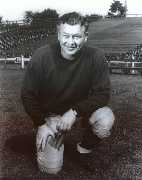
|
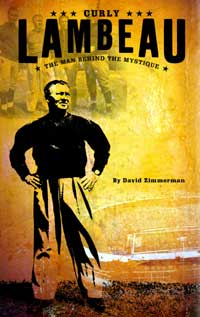
|
In the 38
years since the death of Earl Louis "Curly" Lambeau,Green Bay Packer co-founder,
player and coach, two generations of football fans have followed the fabled
exploits of the team he created. Each and every time they've passed through
the turnstiles of their hallowed stadium, they see his name emblazoned on
the walls: Lambeau Field.
But how many
football fans actually know who he was? What kind of man was Curly Lambeau?
What were his personality traits? How did he put tiny Green Bay, Wisconsin
on the map by building and transforming a town team into a six-time NFL Champion?
The answers
to these and many more compelling questions are now contained in a brand
new book, Lambeau:
The Man Behind the Mystique by David Zimmerman (Eagle Books). Surprisingly
it's the first in depth biography of the man who had such an influence over
the NFL that people have come to know and enjoy today.
|


|

|
|